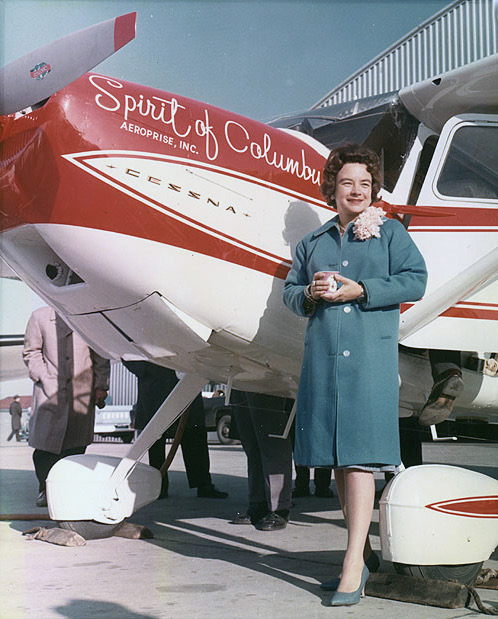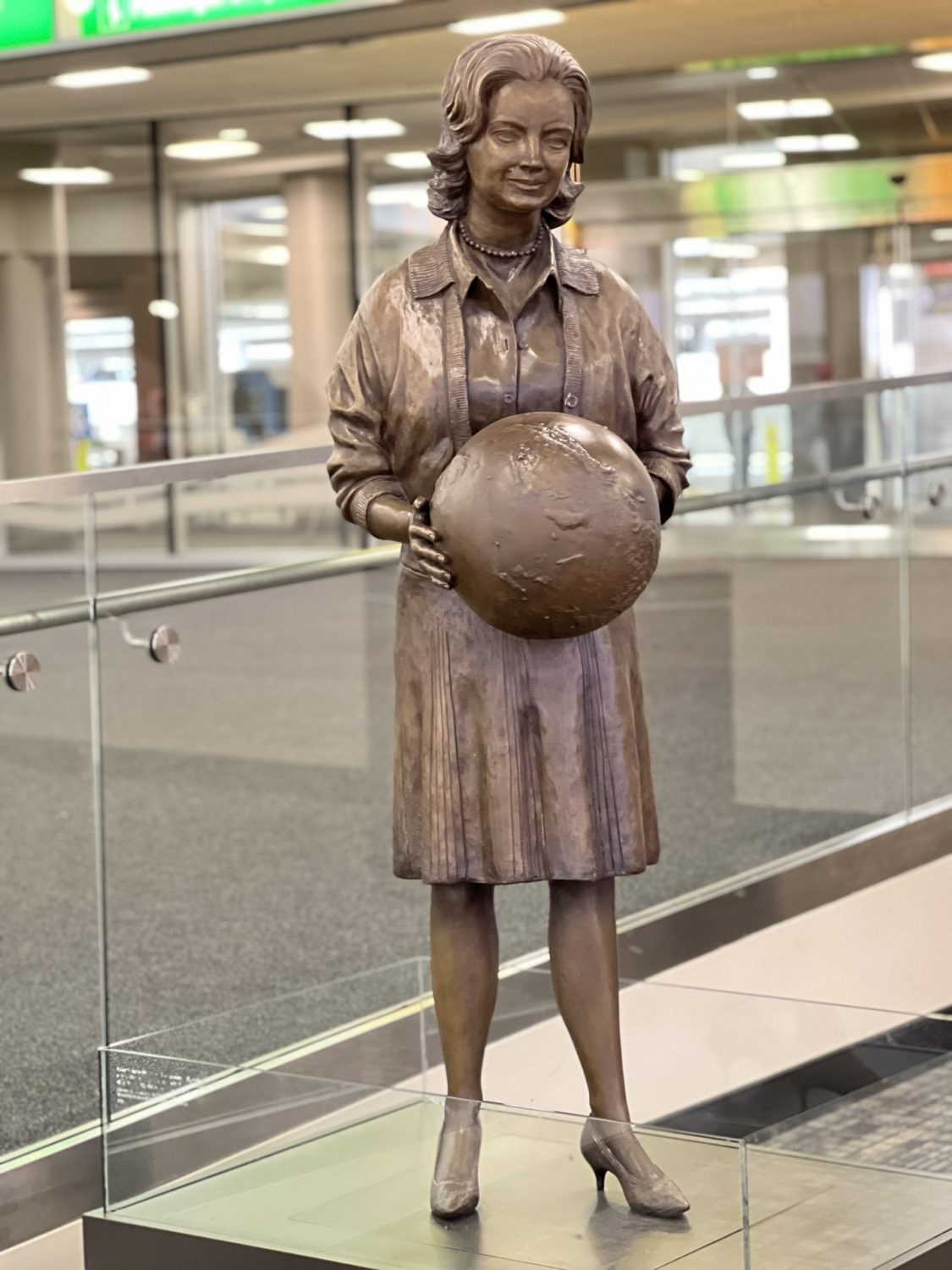Here’s how a Bexley resident became the first woman to fly solo around the world

This story is part of a series that appears regularly on 614Now and (614) Magazine, profiling some of the most interesting and unusual Columbus events that you probably haven’t heard about before. The segment is written by local author and historian, John M. Clark.
Given the love for all things sports in Columbus, you would be excused for first thinking the statue at John Glenn International Airport represents a women’s basketball coach. But that’s no ball the woman is holding. It’s planet Earth, as in the one she circled in a single-engine plane, by herself, in 1964.
From the time Jerrie Mock took a short plane ride with her father at the age of five, the Newark, Ohio, native knew flying was in her blood. As a college student, she studied aeronautical engineering at Ohio State University – the only woman in her class – and the only chemistry student to receive perfect test scores.
At age 20, Mock, for reasons that aren’t entirely clear, dropped out of college. She married an advertising executive, took up residence in Bexley and began raising three children. But thoughts of flying were never far from her mind, and in 1958 she earned her private pilot license. Husband Russ Mock also received his, and soon the couple were half-owners of a decade old, single-engine Cessna with unreliable brakes and a fresh paint job to cover the cracks.
BROUGHT TO YOU BY
When Mock told her husband she was bored sitting at home all day, he said, “Maybe you should get in your plane and just fly around the world.” Russ was joking. But Jerrie took it seriously and began to contemplate the possibility. Soon, she was onboard with the idea. Making her plans in 1963, she didn’t even realize at first that no woman had ever done what she was about to attempt – to complete a solo plane trip around the globe. Amelia Earhart had tried to fly around the world 26 years earlier – but in a much-more sophisticated airplane and with a navigator on board. It was on that attempt that Earhart disappeared.
Mock’s year-long preparations involved planning 19 separate touchdowns in about as many countries. Flight plans had to be filed. Maps were drawn. Foreign embassies had to be informed, lest they mistake her for a spy and have her shot down. Then there was the issue of expenses. Russ, ever the promoter, persuaded the Columbus Dispatch to help finance the trip in exchange for exclusive stories from along the route.
Mock dubbed her plane the Spirit of Columbus. And on March 19th, 1964, after dropping her children off with her mother-in-law, she climbed into the cramped cockpit and took off. “Cramped” because the three other seats in the small plane had been removed and replaced with fuel tanks so that she could make it over the oceans.
Heading east, Mock encountered problems almost immediately. Thick clouds prevented her from making visual assessments of her location. Two onboard directional finders registered 60 degrees apart. Her high-frequency radio would not operate. She overshot her first destination, Bermuda, and had to turn around. Upon landing, winds were so strong that she had to put the weight of her entire 100-pound body on the brakes. And crewmen on the ground had to help stabilize the plane as it literally spun around in the wind. While in Bermuda she had the radio checked out. Someone had deliberately disconnected it.
After such an exhausting and dangerous first leg, few would have blamed Jerrie for giving up. But she persevered. Days were long; stops were short. She washed her one blouse and skirt in hotel room sinks. Weather delays and equipment malfunctions persisted. Then, four weeks later, she made her final refueling stop, in Bowling Green, Kentucky. Russ radioed his wife to ask when she would be home, as the governor, the Federal Aviation Administrator and several thousand fans were waiting to welcome her.
Mock landed at Port Columbus Airport on April 17th, 1964 – 29 days and 23-thousand miles after she had started. She had set seven aviation records, including the first woman to fly over both the Atlantic and Pacific Oceans. A month later, Mock and her family traveled to Washington, D.C., where President Johnson awarded her the FAA’s prestigious Exceptional Service Decoration.
Many expected Mock’s fame to continue. One TV game show host went so far as to suggest Doris Day would portray Mock in a movie about her incredible feat. But no movie offers came. Mock continued to fly, and she set more records. But the public soon forgot about her. Some have speculated that the social turbulence of the ‘60s diverted attention from her. Mock eventually divorced her husband, moved to Florida and bought a small house with her divorce settlement. Even her neighbors didn’t know she was a record-setting aviatrix.
On April 17th, 2014, exactly 50 years from the day she finished her famous flight, Jerrie Mock was honored with a sculpture by local artist Renate Fackler at Port Columbus Airport. (Columbus would honor another local aviator, John Glenn, by re-naming the airport in his honor two years later.) Mock didn’t attend the unveiling ceremony, but she did send greetings by video: “Columbus is a great community, and I appreciate all that you are doing to respect its history and to bring an even better future. Long live the spirit of Columbus.”

Jerrie Mock died five months later, at the age of 88. At her request, her ashes were scattered over the Gulf of Mexico. And the Spirit of Columbus? In 1975, it was donated to the National Air and Space Museum. Today, you can see it at the museum’s Steven F. Udvar-Hazy Center in Chantilly, Virginia.
Want to read more? Check out our print publication, (614) Magazine. Learn where you can find a free copy of our new November issue here!
BROUGHT TO YOU BY




